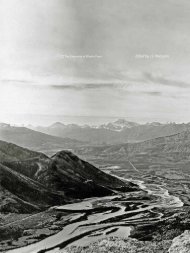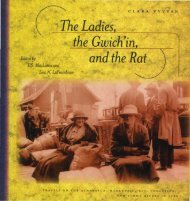Paul Kane's Journal of his Western Travels, 1846-1848 - History and ...
Paul Kane's Journal of his Western Travels, 1846-1848 - History and ...
Paul Kane's Journal of his Western Travels, 1846-1848 - History and ...
Create successful ePaper yourself
Turn your PDF publications into a flip-book with our unique Google optimized e-Paper software.
st<strong>and</strong>s a few Words <strong>of</strong> Cree . . . . Can have no pretensions to<br />
look forward to advancement" (204).<br />
Dog lake Along the fur trade route north <strong>of</strong> Lake Superior, t<strong>his</strong><br />
is the only lake <strong>of</strong> appreciable size on the eastern side <strong>of</strong> the<br />
height <strong>of</strong> l<strong>and</strong>. See also big dog poartage.<br />
dogs bed<br />
See Lake Winapeg.<br />
dry dance Mounten lbis hill, in modem southwestern<br />
Manitoba, has not been identified, but, from the other locations<br />
named by Kane, it is clear that it is situated east <strong>of</strong> the<br />
Turtle Mountains <strong>and</strong> <strong>of</strong> the Pembina River. Both the journal<br />
<strong>and</strong> WA (53-54) provide full accounts <strong>of</strong> the name <strong>of</strong> t<strong>his</strong><br />
rise.<br />
Eales/EaUs The Reverend Cushing Eells, with the Reverend<br />
Elkanah Walker, established a Presbyterian mission to the<br />
Spokane Indians at Tshimakain in 1844; it was ab<strong>and</strong>oned in<br />
<strong>1848</strong>, the year after Kane visited it <strong>and</strong> as a consequence <strong>of</strong><br />
the Cayuse wars, the outbreak <strong>of</strong> which occurred with the<br />
murder <strong>of</strong> the Whitmans, colleagues <strong>of</strong> Eells <strong>and</strong> Walker.<br />
The first reference to the "Methedist mishon <strong>of</strong> Mr<br />
Wacker <strong>and</strong> Eales" is incorrect (<strong>and</strong> is not repeated in WA):<br />
the Methodist mission at The Dalles, which Kane remarks<br />
passing on July 7, 1847, was founded by the Reverend<br />
H. K. W. Perkins at Wascopam in April, 1838. By 1847, it<br />
was being run by the American Board <strong>of</strong> Commissioners for<br />
Foreign Missions.<br />
Edmonton/Edmunton Fort Edmonton (est. 1795; moved 1812)<br />
was visited by Kane September 27 to October 5, <strong>1846</strong>, December<br />
5, 1847 to January 5, <strong>1848</strong>, <strong>and</strong> for portions <strong>of</strong> March,<br />
April, <strong>and</strong> May, <strong>1848</strong>. The northernmost post on the North<br />
Saskatchewan River, named by Chief Factor William Tomison<br />
for the baptismal place in Engl<strong>and</strong> <strong>of</strong> <strong>his</strong> clerk, John Peter<br />
Pruden (see Prudence, Mr.), Fort Edmonton was built into an<br />
important post even though peace was precariously maintained<br />
among the various warring <strong>and</strong> starving tribes who traded,<br />
visited, <strong>and</strong> occasionally lived at it. Extremely well built <strong>and</strong><br />
fortified, it was consequently referred to by its sobriquet,<br />
"Sanspareil. "<br />
eraquay /Eraquay/Eraqua/Eroqua Kane means Iroquois,<br />
the tenn designating the six tribes - Seneca, Cayuga,<br />
Onondaga, Oneida, Mohawk, <strong>and</strong> Tuscarora - originally inhabiting<br />
only upper New York state. Having, for the most part,<br />
supported the Loyalists in the American Revolution, Iroquois<br />
tribes continued peaceful relations with the British when they<br />
migrated northward. The Kanawake reserve near Lachine<br />
(outside Montreal) supplied many workers for the HBe.<br />
fall <strong>of</strong> the Pransin Horses or silver fall On the lower Winnipeg<br />
River between Lac du Bormet <strong>and</strong> Lake Winnipeg, t<strong>his</strong> fall<br />
(Eaux qui Remuent was its French name) <strong>of</strong> twenty feet was<br />
passed by <strong>Kane's</strong> brigades on June 10, <strong>1846</strong>, <strong>and</strong> August 3,<br />
<strong>1848</strong>. Three hydroelectric dams have flooded t<strong>his</strong> portion <strong>of</strong><br />
the river.<br />
Fort Alax<strong>and</strong>er/Fort Alex<strong>and</strong>er Fort Alex<strong>and</strong>er (est. 1783)<br />
was visited by Kane June 11, <strong>1846</strong>, <strong>and</strong> July 30 to August 3,<br />
<strong>1848</strong>. lbis post was located on the Winnipeg River, three<br />
miles from its mouth, on the east bank.<br />
Fort Asneboin See Frot Asneboin.<br />
The American Art <strong>Journal</strong>/Volume XXI • Number 2<br />
Fort Frames See fourt Frances.<br />
Fort Garey Upper Fort Garry (est. 1835) was visited by Kane<br />
June 15-17 <strong>and</strong> July 2-4, <strong>1846</strong>. Located at the forks <strong>of</strong> the<br />
Assiniboine <strong>and</strong> Red rivers, seventy miles north <strong>of</strong> the Manitoba/Minnesota<br />
<strong>and</strong> North Dakota border, t<strong>his</strong> fort was<br />
erected on the site <strong>of</strong> Fort Rouge, established by Pierre de la<br />
Verendrye in 1738. It was named for Nicholas Garry, one <strong>of</strong><br />
the London governors <strong>of</strong> the HBC. In 1876, its name was<br />
changed to Winnipeg.<br />
Fort victoria Fort Victoria (est. 1843) was visited by Kane<br />
April9toMay6, <strong>and</strong> May 14 to June 10,1847. T<strong>his</strong> post was<br />
established as the HBC' s alternative hub on the Pacific Slope to<br />
Fort Vancouver, which, especially with the Great Migration<br />
along the Oregon Trail in 1843, appeared destined to become<br />
American territory. 1be new post was named for the British<br />
monarch who had come to the throne in 1837.<br />
Fort Willam/fort WiUam/Willwn Fort William (est. 1679)<br />
was visited by Kane May 24, <strong>1846</strong>, <strong>and</strong> September 19, <strong>1848</strong>.<br />
On the Kaministikwia River in Thunder Bay, Lake Superior,<br />
t<strong>his</strong> fort was built in 1679, but was not known by the English<br />
name until the nineteenth century. Named for William Mc<br />
Gillivray, President <strong>of</strong> the North West Company, it became the<br />
Great Lakes' hub <strong>of</strong> Canadian fur trading in 1803, after border<br />
surveys determined that the former tenninus, Gr<strong>and</strong> Portage,<br />
lay in American territory, <strong>and</strong> therefore, that Americans were<br />
entitled to levy duties on goods passing through it. In 1970, the<br />
name <strong>of</strong> Fort William was changed to Thunder Bay, Ontario.<br />
fourt Frances/Fort Franses Fort Frances (est. 1731) was<br />
visited by Kane June 4-5, <strong>1846</strong>, <strong>and</strong> August 23 to September<br />
10, <strong>1848</strong>. lbis post at Rainy Lake stood on the site where<br />
Pierre de la Verendrye (1685-1749) had established Fort St.<br />
Pierre in 1731. Kane errs in attributing the name to "Ladey<br />
Simsons sister Mrs. Findelson"; the fort was named for Lady<br />
Simpson herself in 1830, after she passed it during her honeymoon<br />
trip from Lachine (near Montreal) to York Factory.<br />
Fracher/frasher/~ber/F~bur/F'nRr, Colin WA states:<br />
"A Highl<strong>and</strong>er <strong>of</strong> the name <strong>of</strong> Colin Frazer had joined our<br />
party. He was on <strong>his</strong> way to a small post [Jasper House] ...<br />
where he had resided for the last eleven years. He had been<br />
brought to the country by Sir George Simpson, in the capacity<br />
<strong>of</strong> <strong>his</strong> piper . ... He carried the pipes with him, dressed in <strong>his</strong><br />
Highl<strong>and</strong> costume: <strong>and</strong> when stopping at forts or wherever he<br />
found Indians, the bagpipes were put in requisition, much to<br />
the astonishment <strong>of</strong> the natives, who supposed him to be a<br />
relation <strong>of</strong> the Great Spirit, having, <strong>of</strong> course, never beheld so<br />
extraordinary a looking man: or such a musical instrument,<br />
which astonished them as much as the sound produced" (98-99).<br />
Frances, fourt/Franses, Fort See fourt Frances/Fort<br />
Frames.<br />
Franklin, Sur John Sir John Franklin (1786-1847), British<br />
Arctic explorer, had sailed on <strong>his</strong> third expedition in search <strong>of</strong><br />
the North West Passage in 1845. By June, <strong>1848</strong>, the British<br />
Admiralty decided to send out expeditions in search <strong>of</strong> Franklin's<br />
crew, from whom no word had beea received <strong>and</strong> <strong>of</strong><br />
whom no sightings had been reported since 1845. (The remains<br />
<strong>of</strong> the 139-man crew were not found until 1859. The<br />
cause <strong>of</strong> their deaths is still being studied in the 1980s.) Of<br />
coincidental interest is <strong>Kane's</strong> hearing the news <strong>of</strong> Franklin's<br />
71
















